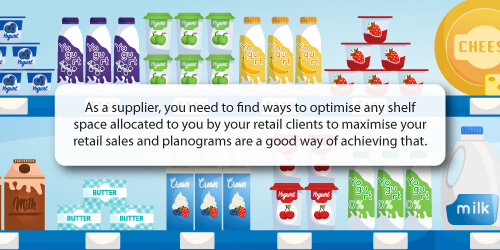Are you a supplier intent on improving your relationship with your retail clients? Then it must be built on trust and open communication. Why? It's so you can align across organisational goals and outputs and when making suggested changes at the store level. That includes tweaks to any planogram* you build so that everyone can benefit from increased sales.

Shelf space efficiency and product assortments are concepts that affect your retail clients as much as they do you. One of the best ways to optimise your space is to use data-driven planograms.
Let's use a practical example to show that.
Have you ever sat on a plane or bus and had to share an armrest with a stranger? More often than not, you'll find yourself 'negotiating' your arm into a comfortable position. Similarly, as a supplier, you must negotiate for shelf space for your products. While the retailer gets your products into the hands of shoppers, it's up to you to ensure your products receive sufficient shelf space.

What are planograms?
There should be constant dialogue between yourself and your retail clients to align your goals and ensure that the products you supply have enough shelf space to increase and maximise your sales.
As a supplier, you can also use data-driven planograms as proof of the value in carrying out any proposed changes. But that doesn't explain the definition of a planogram and why they are critical to your success.
A planogram is a graphical representation of how products should be merchandised on retail shelves to increase sales and improve the shoppability of the category.
Often based on a single category comprising different brands and variations of a grouping of goods, they look at the facings allocated to each product and their positioning.
You can go a step further when using data-driven planograms. Based on sales data captured by your retail client's point of sales system, you can reference this to see if the allocated space is correct or needs adjusting.
Of course, there are many aspects to consider when looking at store performance. You will need to define which metrics you would want to focus on and align accordingly.

Persuading retailers who haven't invested in planograms
While some retailers prefer to generate and manage their planograms in-house, the opposite is true for others. These retailers want you to approach them with a proposed plan for the space allocated to your products. It also helps if you provide them with a planogram that considers your allocated space.
In reality, many retailers would gladly hand over the responsibility of generating planograms to you or other suppliers. Of course, it's critical to point out that they won't hand this responsibility to you without justification.
Instead, you'd need to convince them that allows you to make such a contribution would benefit the overall performance of the category and their store.

Fortunately, convincing your retail clients who don't use space planning is much easier than you think.
Once you get the go-ahead, you can agree on the level of your involvement as a supplier. It is then up to you to pull the relevant sales data required to generate the planogram for the category.
It opens the door for negotiation when you want to allocate more space to your products. Of course, as we already stated, any additional shelf space must align with their strategy. More than that, it needs to make sense to the entire category.
That said, while there are those retailers who want to keep their cards close to their chest, being able to show others what they’re working with can result in bigger, better things for them.
Let’s say, for example, you supply coffee, and your retail client has asked you to help them build a planogram for the category.
Using the provided sales data and spotting an opportunity for category growth, you can approach the retailer and request more space for your product. You have proof in the form of data to back up your request and show that your suggestion is in the best interest of the category.
They’re almost certainly going to see an increase in sales for that category, which means they’ll want to increase their stock orders from you.
Of course, it is not always easy to generate such trust. There are many considerations to make so that you are not only their supplier of choice but that your work aligns with their goals.
 For suppliers who want to foster a better relationship
For suppliers who want to foster a better relationship
The retailer-supplier relationship is a critical partnership you need to foster and maintain if you want to experience future success. It's also not only for your sake as a supplier. This partnership is mutually-beneficial.
Below is a brief overview of the different approaches retailers like to take to category management collaboration.
1. Centralisation
The centralisation approach is hands-on for the retailer, allowing them control over the entire category management process. That means they'll fund the process too.
However, that doesn't mean they won't call on you for assistance. While they might subsidise the process, they can still request your help as and when needed.
2. Category Captain
Another approach is when retailers choose a supplier from a category to become the category captain. It is essentially the opposite of centralisation.
By appointing a category captain, retailers have the opportunity to let their suppliers take on an active role in planning for the category. That includes decisions on how to merchandise the product grouping to increase retail sales.
If a retailer gives the role of category captain to you, the expectation is that your contribution must benefit the overall category performance. Again, it comes down to trust - does the retailer trust that you can help them to grow the category?
It’s worth pointing out that becoming a category captain is most definitely worth the effort.
3. Category Partners
The last approach is the most collaborative form of category management. It's through the use of category partners.
The adage of two heads is better than one rings true here. Because a retailer can leverage the experience of a handful of suppliers for a single category versus one, they have access to a larger pool of knowledge and expertise.
It also allows a retailer multiple viewpoints and can expose them to any gaps that they might not have seen before. This process includes input from both retailers and yourself. Going this route also ensures everyone involved can make better-informed decisions.

How do suppliers benefit by building planograms for retailers
As a supplier, there are multiple benefits in offering to build planograms as a service. You also have a unique value for retailers.
You have access to market data
A retailer only deals with sales data for their stores. Meanwhile, you and other suppliers don’t only supply one store.
You might supply all supermarkets in the area, for example. Without blatantly stating which supermarkets are outselling the others, you have the advantage of taking this information and customising your strategy for each store.

Please be mindful here. While you might have access to information across the industry, it’s critical to show that any retail client can trust you with their data.
You can ensure the correct shelf space for your products
Because you have access to market data and are building planograms for your retail client, you can ensure that each product receives the shelf space it deserves according to its sales. That includes your products.
As mentioned earlier in this article, if you believe your product deserves more space, you can delve into the data to prove why. Armed with this data, you can approach your retail client to show them why they should apportion more space to your product over others.
Keep in mind: doing so isn’t only for your benefit but also for the overall health of the category.
You can increase sales of your products
As you give your products more space on the shelf, the benefit is more sales for your products. More visibility equals more opportunities to sell your items.
It also comes back to another point we made above. By increasing sales for your products, you're improving sales for the entire category and the retailer. If you're also a category captain, you're doing your job - looking after and growing the grouping under your guidance.

What about retailers who have already invested in planograms?
While we have looked at the advantages of offering to build planograms for your retail customers, what happens if they already have a space planning capability? Don't worry; not all is lost.
In reality, we'd argue that you're in a good position.
You could compare your relationship with your retail client to that of a writer and their editor. Let's explain.
The writer (the retailer) produces an article based on information and findings associated with the topic. The editor (the supplier in this case) serves as the second pair of eyes, refining and suggesting changes where necessary while keeping its essence.
Similarly, having your input when planning space allocations facilitates just that. It's an opportunity to have a second pair of eyes look through and comment on what to do differently to yield a better return.
This difference in perspective is vital as it also allows you to sense-check any planograms generated by the retailer.
The information you have in comparison to your retail customer is broader and offers a view that is at a higher level. It allows the retailer to tap into your industry knowledge and expertise.
Sharing this information and insights also provide a perspective they wouldn't have had if they didn't liaise with you or any other supplier.

Conclusion
Be it at store level, Head Office level or that of a multinational retailer, as a supplier, your input on a retailer's space allocation is golden. As a supplier, you have the ability to drive and improve your business and theirs too.
Are you looking for ways to increase the shelf space allocated to your products? Or perhaps you’re interested in learning how to negotiate better deals with your retail clients. Why not book a custom complimentary consultation with a DotActiv expert today to hear how we can help you achieve that or browse through our various services and software editions on our online store?
*This article was updated on Thursday, 27 October 2022.


